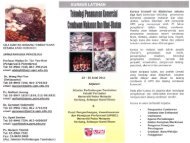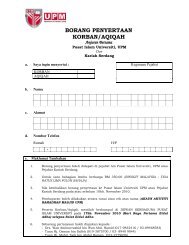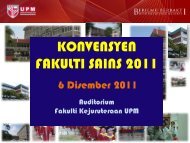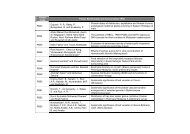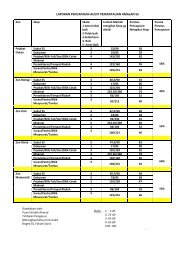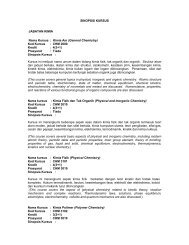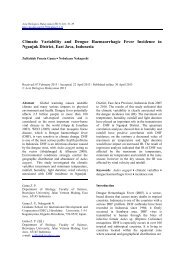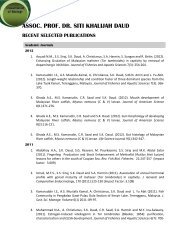Programme Book - UPM - Universiti Putra Malaysia
Programme Book - UPM - Universiti Putra Malaysia
Programme Book - UPM - Universiti Putra Malaysia
Create successful ePaper yourself
Turn your PDF publications into a flip-book with our unique Google optimized e-Paper software.
P05 BIOGAS REFORMING FOR PRODUCTION OFHYDROGEN OVER NANOSTRUCTURED IRON AND NICKELSUPPORTED ACTIVATED CARBON CATALYSTY.H. Taufiq –Yap a,b* , C. Kesamy a,b , S. Sivasangar a,ba Catalysis Science and Technology Research Centre, <strong>Universiti</strong> <strong>Putra</strong> <strong>Malaysia</strong>,43400 <strong>UPM</strong> Serdang, Selangor, <strong>Malaysia</strong>b Department of Chemistry, Faculty of Science, <strong>Universiti</strong> <strong>Putra</strong> <strong>Malaysia</strong>, 43400<strong>UPM</strong> Serdang, Selangor, <strong>Malaysia</strong>Corresponding author: taufiq@upm.edu.myColossal dependency of the fossil fuel to meet the energy demands today has led toserious environmental concerns and sustainability issues. Greenhouse gaseous (GHG)emissions and the depletion of non- renewable resources from extensive fossil fuelburning for energy production, automobile sector and industrial development havepromoted the use of hydrogen as an alternative energy source. Agriculturalwastewater pollutant in South East Asia like palm oil mill effluent (POME) which isrich with biogas like CH 4 and CO 2 is a promising raw material for dry reforming ofmethane to hydrogen production. This study focuses on the development of biogasreforming catalyst using a series of promoters supported on high surface areaactivated carbon via wet impregnation. A comparison between the monometalliccatalyst nickel and iron supported on activated carbon (AC) were conducted and thecatalyst with higher activity were chosen for further modification with secondarypromoters (La, Ba, and Mg) to enhance the selectivity, stability and activity.Thephysicochemical properties of the final catalyst were analyzed using X-Raydiffraction (XRD), BET Surface Area Measurement, Temperature <strong>Programme</strong>dReduction (TPR), Scanning Electron Microscopy (SEM-EDX) and TransmissionElectron Microscopy (TEM). The catalyst was reduced with H 2 gas in a close systemat 700⁰C for 2h. Subsequentlyit was tested in a continuous fixed bed reactor with feedgas mixtures (68% CH 4 and 32% CO 2 ) simulating a clean model of biogas fromPOMEat800⁰C with a flow rate of 30cm 3 min -1 . The obtained results revealed that themonometallic nickel catalyst showed a superior methane conversion and hydrogenproduction over time as compared to iron monometallic supported on activated carboncatalyst.The highest catalytic activity during the period of time studied were obtainedover the 3% Ni on AC catalyst sample. However, the addition of promoters on thenickel catalyst has induced the synergy effect between the secondary promoter andnickel, thus significant improvement was observed in the catalytic activity comparedto monometallic catalyst.20 |16 th Industrial Chemistry Seminar: Chemistry- A Passport to a Brighter Future




